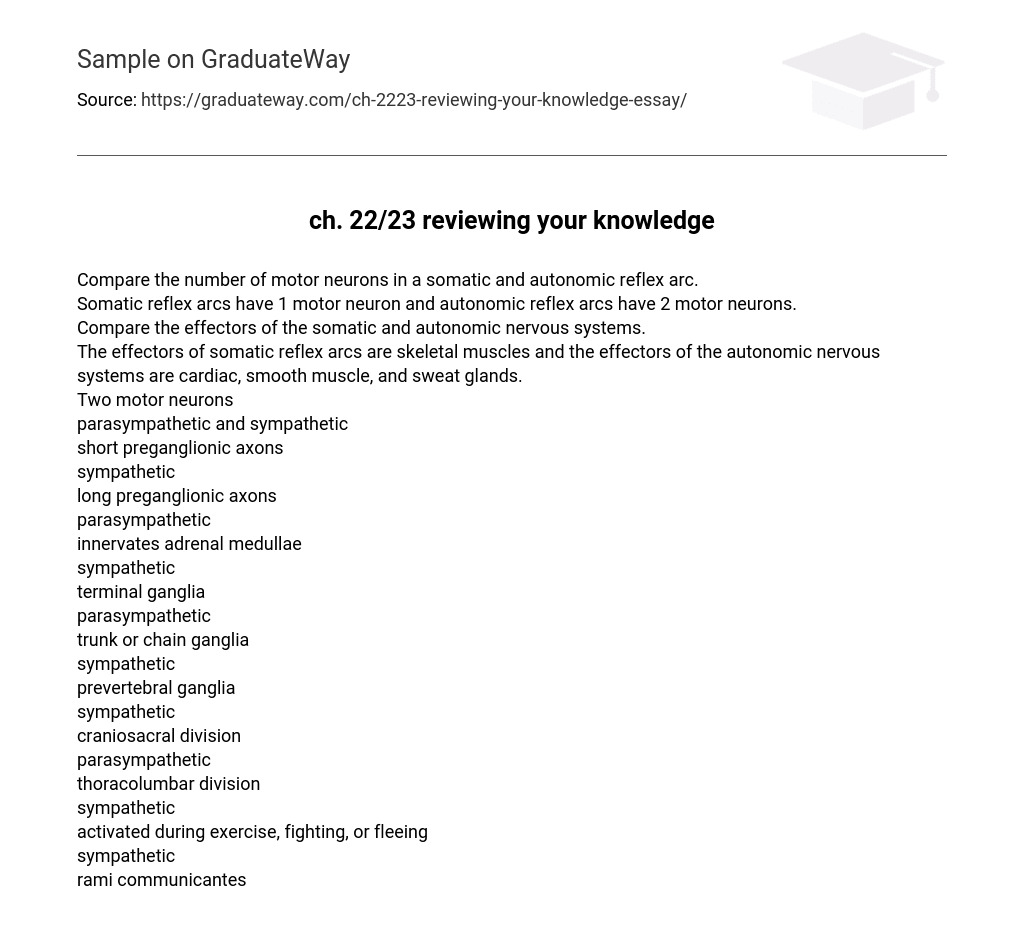Compare the number of motor neurons in a somatic and autonomic reflex arc.
Somatic reflex arcs have 1 motor neuron and autonomic reflex arcs have 2 motor neurons.
Compare the effectors of the somatic and autonomic nervous systems.
The effectors of somatic reflex arcs are skeletal muscles and the effectors of the autonomic nervous systems are cardiac, smooth muscle, and sweat glands.
Two motor neurons
parasympathetic and sympathetic
short preganglionic axons
sympathetic
long preganglionic axons
parasympathetic
innervates adrenal medullae
sympathetic
terminal ganglia
parasympathetic
trunk or chain ganglia
sympathetic
prevertebral ganglia
sympathetic
craniosacral division
parasympathetic
thoracolumbar division
sympathetic
activated during exercise, fighting, or fleeing
sympathetic
rami communicantes
sympathetic
promotes digestion
parasympathetic
short postganglionic axons
parasympathetic
long postganglionic axons
sympathetic
list the components of the autonomic reflex arc. Compare with somatic reflex arc.
Sensory receptor, sensory neuron, integrating center, 2 motor neurons, effector. They both have the same components except the autonomic reflex arc has 2 motor neurons and the somatic reflex arc has 1 motor neuron.
Where are autonomic integrating centers located?
The hypothalamus, brainstem, and lateral gray horn of spinal cord arc where the autonomic integrating centers are located.
Are the autonomic integrating centers monosynaptic or polysynaptic?
Polysynaptic
Can the autonomic integrating centers be influenced by higher brain area?
yes
Describe the function of sensory receptors.
The function is to convert sensory stimuli into changes in membrane potential in the sensory neuron. If these changes are great enough, a nerve impulse will be generated in the sensory neuron.
Name the general sensory receptors that belong to each structural class.
a) free nerve endings
b) encapsulated nerve endings
a) hair root plexus, type I cutaneous mechanoreceptors, warm receptors, cold receptors, nociceptors.
b) corpuscles of touch, type II cutaneous mechanoreceptors, lamellated corpuscles, muscle spindles, tendon organs.
Receives input from third order neurons; sensory information is consciously perceived.
cerebral cortex
cell body located in spinal cord or brain stem
second-order neuron
gateway to cerebral cortex, location of synapse between second and third order neurons.
thalamus
neuron associated with sensory receptor.
first-order neuron
relays sensory nerve impulses from thalamus to cerebral cortex.
third-order neuron
cell body for first order neuron located here
posterior root ganglion
Describe correlation between tactile density of a body area and the size of the cerebral cortex receiving information from those receptors.
The greater the density of tactile receptors in a body area, the greater the area of cerebral cortex receiving information from these receptors.
define adaptation
the decrease in nerve impulses generation in sensory nerves that occurs when sensory receptors are continually stimulated.
do warm receptors adapt quickly?
yes
do cold receptors adapt quickly?
yes
define referred pain.
a pain sensation originating in a visceral organ that is perceived in a specific region of the body surface that is innervated by the same spinal segments.
After the subject’s elbow had been immerse in water for 2min, where was the referred pain located? Explain.
In the class experiment, after the elbow was immersed in water referred pain was felt in the forearm and medial hand.
Remember! This essay was written by a student
You can get a custom paper by one of our expert writers
Order custom paper
Without paying upfront

